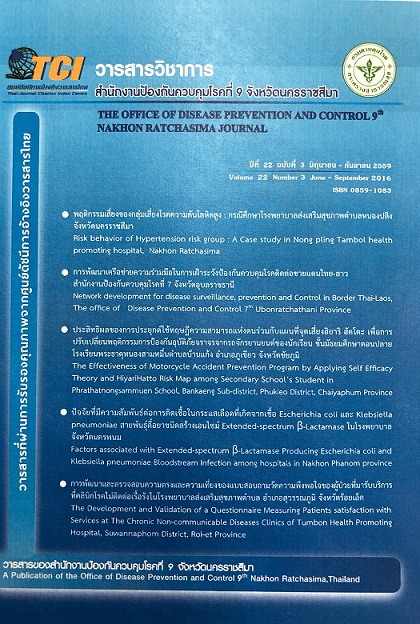Factors associated with Extended-spectrum -Lactamase Producing Escherichia coli and Klebsiella pneumoniae Bloodstream Infection among hospitals in Nakhon Phanom province
Keywords:
Extended-spectrum -Lactamase, Escherichia coli, Klebsiella pneumoniae, Bloodstream infectionAbstract
The aim of this study was to investigate factors associated with Extended-spectrum -Lactamase
Producing Escherichia coli and Klebsiella pneumoniae (ESBLs) bloodstream infection among hospitals
in Nakhon Phanom Province. The study design was a Case-Control Study and data collected from
hospital base in Nakhon Phanom province during 1 Jan. 2014 to 31 Dec. 2014. Participants included
89 patients infected with ESBLs and 89 patients infected with non-ESBLs. The descriptive statistics,
simple logistic regression and multiple logistic regression were using to evaluate factors potentially
associated with ESBLs infection. On multivariate analysis, four predictors associated with ESBL-producing
pathogens bloodstream infection in the hospitals of Nakhon Phanom Province included male sex
(ORadj = 2.43, 95% CI: 1.23-4.79), chronic kidney disease (ORadj = 3.86, 95% CI: 1.44-10.34),
prolong admission 7 days (ORadj = 2.10, 95% CI: 1.08-4.08) and prior cephalosporins therapy
(ORadj = 4.40, 95% CI: 1.93-10.02). This study demonstrates several risks factors associated
with ESBL-producing E. coli or K. pneumoniae infection occurring during treatment in hospital.
The cooperation of healthcare provider’s response for surveillance and control of infections in hospital
can help to reduce the incidence of ESBL-producing pathogens in patients.
References
(INICC) report, data summary of 43 countries for 2007-2012 Device-associated module.
Am J Infect Control 2014; 42(9):942-56.
2. Danchaivijitr S, Tangtrakool T, Waitayapiches S, et al. Eff i cacy of hospital infection control in
Thailand 1988-1992. J Hosp Infect 1996; 32(2):147-53.
3. Rongrungruang Y, Sawanpanyalert N, Chomdacha P, et al. Health-Care Associated Infections in
Thailand 2011. J Med Assoc Thai 2013;96(2):117-23.
4. พรพิศ ตรีบุพชาติสกุล, นาตยา คำสว่าง, ปัญญา เถื่อนด้วง. ผลการรักษาผู้ป่วยติดเชื้อในกระแสเลือด
ตามแนวเวชปฏิบัติหลังใช้ระบบพยาบาลผู้ประสานงาน. พุทธชินราชเวชสาร. 2552;26(1): 29-36.
5. Anderson DJ, Moehring RW, Sloane R, et al. Bloodstream Infections in Community Hospitals
in the 21st Century: A Multicenter Cohort Study. PLOS ONE 2014; 9(3):e91713.
6. Smet A, Martel A, Persoons D, et al. Broad-spectrum b-lactamases among Enterobacteriaceae
of animal origin:molecular aspects, mobility and impact on public health. FEMS Microbiology
Rev 2009;34(3):295-316.
7. Briongos-Figuero LS, Gmez-Traveso T, Bachiller-Luque P, et al.. Epidemiology, risk factors
and comorbidity for urinary tract infections caused by extended-spectrum beta-lactamase
(ESBL)-producing enterobacteria. Int J Clin Pract 2012; 66(9): 891-6.
8. Anunnatsiri S, Towiwat P, Chaimanee P. Risk factors and clinical outcomes of extended spectrum
beta-lactamase (ESBL)-producing Escherichia coli septicemia at Srinagarind University
Hospital, Thailand. Southeast Asian J Trop Med Public Health 2012; 43(5): 1169-77.
9. Hadic S, Custovic A, Smajlovic J, et al. Distribution of nosocomial infections caused by Klebsiella
pneumoniae ESBL strain. J Environ Occup Sci 2012; 1(3): 141-6.
10. Chetcuti ZS, Azzopardi N, Sant J. Mortality risk score for Klebsiella pneumoniae bacteraemia.
Eur J Intern Med 2014; 25(6): 571-6.
11. สำนักงานนิเทศและประชาสัมพันธ์ กระทรวงสาธารณสุข. สถานการณ์เชื้อดื้อยาปฏิชีวนะในไทย [อินเทอร์เน็ต]
2556 [เข้าถึงเมื่อ 10 สิงหาคม 2558]. เข้าถึงได้จาก: http://narst.dmsc.moph.go.th/news001.html.
12. Schlesselman JJ. Case-Control Studies: Design,Conduct, Analysis. USA: Oxford University; 1982.
13. Hsieh FY, Block DA, Larsen MD. A simple method of sample size calculation for linear and logistic
regression. Stat Med 1998; 17(14): 1623-34.
14. Leistner R, Sakellariou1 C, Grntke S, et al. Mortality and molecular epidemiology associated with
extended-spectrum -lactamase production in Escherichia coli from bloodstream infection.
Infect Drug Resist 2014; 7: 57–62.
15. Nakai H, Hagihara M, Kato H, et al. Prevalence and risk factors of infections caused by
extended-spectrum b-lactamase (ESBL)-producing Enterobacteriaceae. J Infect Chemother
2016; 22(5):319-26.
16. Grntke S, Kohler C, Steinmetz I, et al. Molecular epidemiology of extended-spectrum beta-lactamase
(ESBL)-positive Klebsiella pneumoniae from bloodstream infections and risk factors for
mortality. J Infect Chemother 2014; 20(12): 817-9.
17. Kengkla K, Charoensuk N, Chaichana M, et al. Clinical risk scoring system for predicting extended
spectrum b-lactamase-producing Escherichia coli infection in hospitalized patients. J Hosp
Infect 2016; 93(1): 49-56.

Published
How to Cite
Issue
Section
License
บทความที่ลงพิมพ์ในวารสารวิชาการสำนักงานป้องกันควบคุมโรคที่ 9 จังหวัดนครราชสีมา ถือว่าเป็น
ลิขสิทธิ์ สำนักงานป้องกันควบคุมโรคที่ 9 จังหวัดนครราชสีมา



